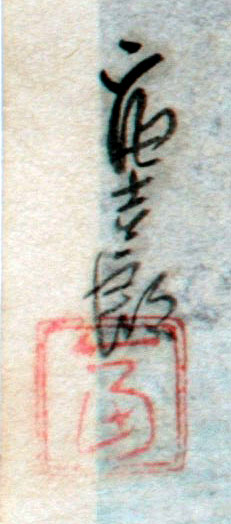Description: |
Dôjima-gawa kaki-fune (Oyster boat on the Dôjima River, 堂島川かき舟) from the series Osaka meisho (Famous places in Osaka, 大阪名所) |
|
Signature: |
"T. Tokuriki” in pencil at lower left of image and brushed signature on the reverse |
Seals: |
No artist seal |
Publisher: |
Matsukyû (末詳) |
Date: |
Self-carved;
Printed c. 1950s-60s |
Format:
(H x W) |
Modern print, large ôban
26.3 x 39.2 cm |
Impression: |
Excellent, with copious gofun (white shell powder) |
Condition: |
Excellent color, unbacked; red artist seal on verso faint in LR corner |
Price (USD/¥): |
|
Comments: |
Background
Tokuriki Tomikichirô (1902-2000 徳力富吉郞) was born in Kyoto. He graduated from the Kyoto City School of Fine Arts and Crafts and the Kyoto City Specialist School of Painting in 1924. He also studied nihonga (Japanese-style painting: 日本画) at the private school of Tsuchida Bakusen (1887-1936) and with Yamamoto Shunkyo (1871-1933). From 1929 Tokuriki focused on mokuhanga (block prints: 木版画), and he also actively promoted sôsaku hanga ("creative prints": 創作版画) in Kyoto. He published many sets and series before World War II, and afterwards established the Matsukyû (末詳) Publishing Company to produce and distribute his prints and through its subdivision, Kôrokusha (紅録社), to publish self-carved and self-printed hanga as well as works by other artists such as Kotozuka Eiichi (1906-1979), Takahashi Tasaburô (1904-1977), and Kamei Tôbei (1901-1977). For much of his long life Tokuriki taught many artisans and artists, some of them non-Japanese, and he traveled extensively, thus his influence was significant in the world of hanga. He is perhaps best known to Westerners through his many print designs in the shin hanga ("new prints": 新版画) manner for various series published by the three main Kyoto firms — Uchida, Unsôdô, and Kyoto Hanga-in. His self-carved, self-printed sôsaku hanga, such as the example we are offering here, are highly valued by collectors and curators. The artist recognized this dichotomy, saying, "I'd rather do nothing but creative prints, but after all, I sell maybe ten of them against two hundred for a publisher-artisan print."
For more about this artist, see Tokuriki Tomikichirô Biography.
Design
  Oyster culture or farming as an industry dates back to at least the second quarter of the seventeenth century in Japan, specifically in Hiroshima Prefecture, when it was discovered that oysters settled on stones and on the bamboo poles of fish traps. (Oyster consumption, however, has been part of the Japanse diet for millenia.) The molluscs were then replanted in intertidal zones surrounded by bamboo fences to keep predators out. Japanese oysters are at their best in late winter and early spring, and, indeed, Tokuriki's design features a floating oyster restaurant on a snowy day. This type of boat or barge is similar to those used during the Edo period. Some of Osaka's modern commercial buildings can be seen in the distance. Tokuriki makes effective use of reflected yellow incandescent lighting from within the riverside buildings. Oyster culture or farming as an industry dates back to at least the second quarter of the seventeenth century in Japan, specifically in Hiroshima Prefecture, when it was discovered that oysters settled on stones and on the bamboo poles of fish traps. (Oyster consumption, however, has been part of the Japanse diet for millenia.) The molluscs were then replanted in intertidal zones surrounded by bamboo fences to keep predators out. Japanese oysters are at their best in late winter and early spring, and, indeed, Tokuriki's design features a floating oyster restaurant on a snowy day. This type of boat or barge is similar to those used during the Edo period. Some of Osaka's modern commercial buildings can be seen in the distance. Tokuriki makes effective use of reflected yellow incandescent lighting from within the riverside buildings.
Note: There is also, most unusually, a brushed signature (Tomikichirô, 富吉郞) and seal (Tomi, 富) on the verso (see detail on left). This print is also accompanied by a presentation sheet with a short text (see detail on right).
Prints by Tokuriki are in the Aichi Prefectural Museum of Art, Nagoya; Art Gallery of Greater Victoria; Brooklyn Museum, NY; Carnegie Museum of Art;Fine Arts Museums of San Francisco; Five College Museums/Historic Deerfield Collections; Harvard Art Museum; Los Angeles County Museum of Art; Museum of Fine Arts, Boston; National Museum of Modern Art, Tokyo; Smart Museum of Art, University of Chicago; University of Alberta Art Collection; Weatherspoon Art Museum, Greensboro; and Yale University Art Gallery.
BIBLIOGRAPHY
- Fujikake, Shizuya: Japanese Woodblock Prints. Tokyo: Tourist Library 10, Japan Travel Bureau, enlarged and rev. ed., 1949.
- Merritt, Helen: Modern Japanese Woodblock Prints: The Early Years. Honolulu: University of Hawaii Press, 1990, pp. 88-92.
- Statler, Oliver: Modern Japanese Prints: An Art Reborn. Rutland: Tuttle, 1956, pp. 118-122, 126, 199; nos. 72-73.
- Tokuriki, Tomikichirô: Woodblock Printing. (trans. Arimatsu Teruko) Osaka: Hoikusha Publishing Company, 1968.
- Zehnder, Amanda (intro.): Modern Japanese Prints: The Twentieth Century. Pittsburgh, PA: Carnegie Museum of Art, 2009, pp. 174-177.
|
|